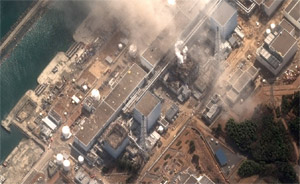Buddhist Impermanence at Fukushima Daiichi

Abstract
On March 11th, 2011 a 9.0 magnitude earthquake generated a devastating tsunami which lead to thousands of deaths and the partial meltdown of three nuclear reactors at the Japanese power plant Fukushima Daiichi. The resulting evacuation zone created an uninhabitable region in all directions 20km from the reactors with no foreseeable solution to a widening nuclear disaster.
Tracing a buddhist ecological thread, my paper intertwines the concept of impermanence (anitya) with the shifting architectonics of ritual space. A historical trajectory of buddhist embodiment originates in the aniconic phase (5th century - 1st century BCE) with specific focus on subsequent containment of the buddha body in two temples - Wat Si Chum at Sukhothai, in northern Thailand and Manuha in Bagan, Burma. The architectural containment of the buddha body is theoretically and visually juxtaposed to the failure of containment in the partial nuclear meltdowns of reactors 1, 2, and 3 at Fukushima Daiichi.
 By exploring embodied notions of, and limits to, buddhist ideals where humans can not be present - near critical reactors and below the ocean surface - I consider how the body and its containment delimits an engaged buddhist response to the crisis. Buddhist concepts of non-violence (ahimsa) and skillful means (upaya) are applied to the suffering of the people on land and to the subsurface inhabitants off the coast of Japan.
By exploring embodied notions of, and limits to, buddhist ideals where humans can not be present - near critical reactors and below the ocean surface - I consider how the body and its containment delimits an engaged buddhist response to the crisis. Buddhist concepts of non-violence (ahimsa) and skillful means (upaya) are applied to the suffering of the people on land and to the subsurface inhabitants off the coast of Japan.
To supplement the theoretical, and as a means to explore this (impossible) site of engaged buddhist ritual, an online virtual world is being constructed in the open-source video game environment Unity. In this virtual world, a buddhist figure is placed within the reactor core to achieve presence in a forbidden zone. Imbedded in the figure is a networked computer which allows online participants to enter the reactor from inside the buddha body/image. Once inside, visitors can meditate on impermanence and/or engage in acts of loving-kindness (metta) toward the seemingly insurmountable problem contained therein. This virtual sangha will occupy an uninhabitable temple space in a collective act of engaged response. Upon departure, visitors are given the opportunity to employ skillful means in the proposal of innovative design solutions to prevent such disasters from ever happening again.
 The intent through this hybrid configuration of theory and practice is to address what is always already a state of suffering and enlightenment through a rigorous address of buddhist embodiment, architecture, and impermanence. Power, presence, and skillful means are deployed in a interdisciplinary hybrid of buddhist studies, digital media and creative praxis to ask: How can buddhism consider the violence of nature? Is the successful containment of nuclear power possible through architectural means? What does an engaged buddhist response to an event where the body can not be present look like?
The intent through this hybrid configuration of theory and practice is to address what is always already a state of suffering and enlightenment through a rigorous address of buddhist embodiment, architecture, and impermanence. Power, presence, and skillful means are deployed in a interdisciplinary hybrid of buddhist studies, digital media and creative praxis to ask: How can buddhism consider the violence of nature? Is the successful containment of nuclear power possible through architectural means? What does an engaged buddhist response to an event where the body can not be present look like?
This paper and accompanying project are currently in development.
